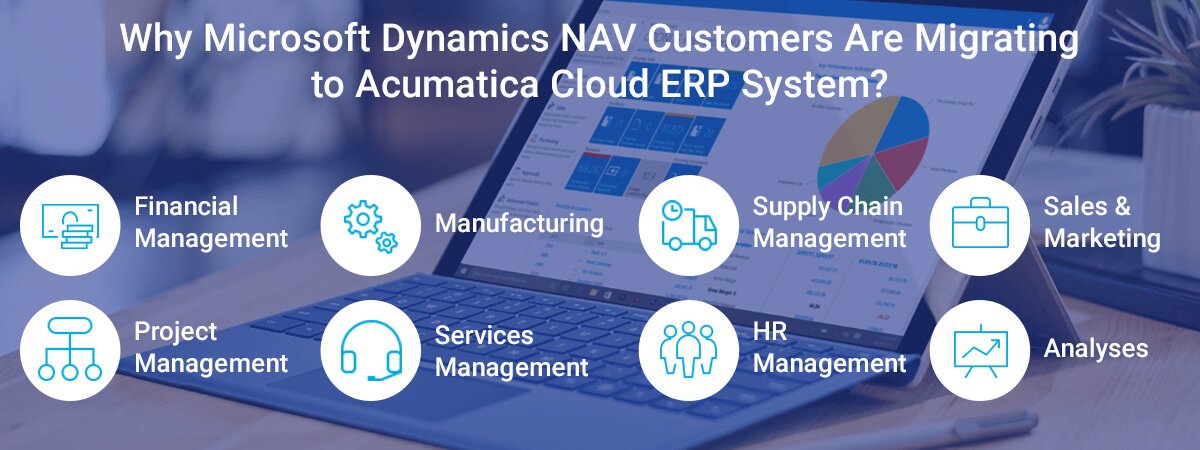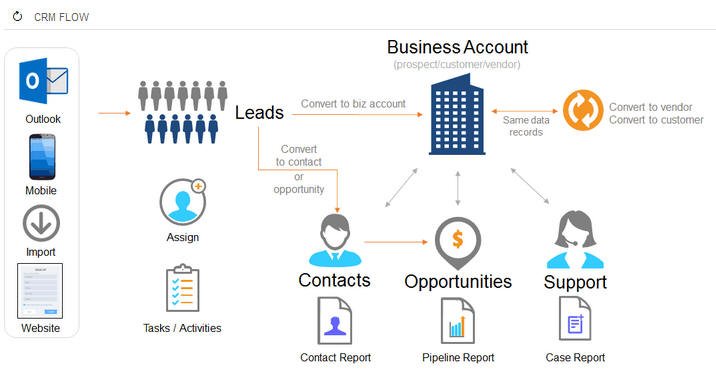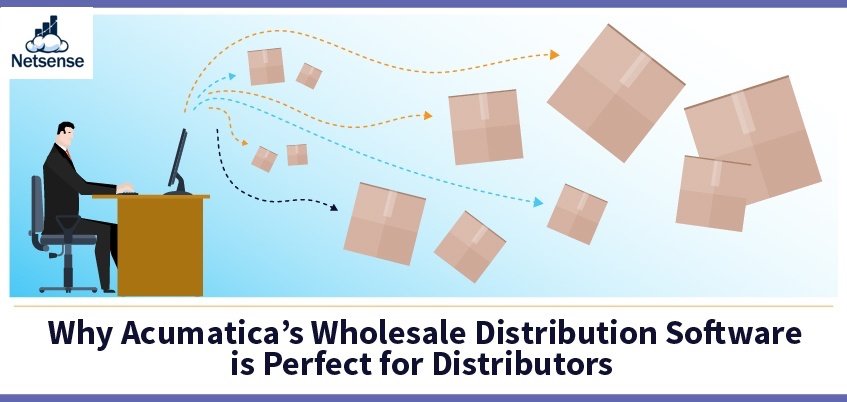The time has arrived for Microsoft Dynamics NAV users to make a rational decision for a new ERP implementation to access distinctive capabilities and thrive in the digital economy. While this ERP product made several enhancements over the years, it still uses the same proprietary code, the same client-server architecture, and the same data structures. Its obsolete architecture could be a big issue for the newest technologies, such as cloud deployment options, CRM integration, and customisation using development tools. Microsoft has redesigned NAV to ensure cloud compatibility and rebranded it as Microsoft Dynamics 365 Business Central. However, it still utilises the old software, and upgrading to Business Central will require rewriting customisation which is an expensive affair. Comparing Acumatica vs Microsoft Dynamics 365 Business Central Microsoft Dynamics 365 Business Central (formerly Dynamics NAV) is a mid-market ERP product that offers: Customizability Third-party software support Support for vertical industries Cloud and on-premises deployment options However, there are drawbacks to Business Central: NAV users must rewrite many of their customizations before moving to Business Central after the Spring 2019 release. Business Central users can’t request a copy of their production database. Many of the third-party solutions available for NAV are not available yet for Business Central. Acumatica offers significant features and capabilities over Business Central. Take a look at how Acumatica compares with Dynamics 365 Business Central: Are you looking for the right business management software? Thousands of companies are moving to the Acumatica Cloud ERP system to gain a competitive edge, reduce upfront costs, and streamline business operations. Microsoft Dynamics NAV offers several benefits listed as: Flexibility and customisation Extensive support for different industries Third-party software support Acumatica ERP provides these same capabilities, but it comes with significant features and functionality that MS NAV doesn’t. Further, we will do a comparison between Acumatica ERP and Microsoft Dynamics NAV to show you how they differ. True CloudAcumatica was built in the cloud right from the beginning and it works with both on-premises or in the cloud without any additional software or equipment. On the contrary, MS Dynamics NAV is an old client-server product and wasn’t designed for the cloud. It can be hosted on a remote server that needs a web server add-up for web support. Customisations with Industry-Standard ToolsBoth software products are configurable, however, Acumatica ERP is developed using industry-specific C# and .NET. Since MS Dynamics NAV utilises the old proprietary code, customisations may become daunting and costly. FlexibilityAcumatica ERP is a complete, multi-site system that can be accessed using web-enabled devices, from any location at any time. Every screen gives the same data and flows, no matter whether it’s a PC, mobile phone, or tablet. On the other hand, MS NAV needs coding to resize pages for different screens, sizes, and resolutions. Deployment OptionsAcumatica ERP supports multiple deployment options, including cloud, on-premises, and hybrid. However, as MS Dynamics NAV is built on old technology, it cannot run in the public cloud. The only choice NAV users have is to run it on-premises or use a private hosting vendor.Moreover, because NAV needs additional web servers to permit cloud configuration and custom pages are resized to support tablet and phone access, the total cost of ownership (TCO) also increases for cloud options. Adapt to Business GrowthCompanies should choose an ERP solution for both current needs and the future. Acumatica ERP doesn’t charge by users, just for computing power required which gives unlimited user accessibility. On the other side, Dynamics NAV is licensed by a user and as your firm grows, you will have more employees, suppliers, and customers so costs will increase fast. How Acumatica Cloud ERP Software Beats Microsoft Dynamics NAV?As we have discussed above, Microsoft Dynamics NAV still uses old technology at its core and on-premises NAV users need to pay a huge amount to meet its new Business Central requirements. [On the contrary, Acumatica ERP was designed to be accessible through the cloud, using scalable and modern web technology to completely integrate CRM and ERP solution on a budget, whether deployed in the cloud or on-premises. Acumatica ERP offers best-in-class functionality, superior performance, ease of use, and best value to small and mid-sized enterprises. It provides a consistent environment across the organisation with no downtime, which enhances productivity and gives one database that you can access anywhere. With the potential changes Microsoft has announced for NAV users, Acumatica ERP is a great alternative to meet or exceed your business requirements today and in the future. About Microsoft Dynamics 365 Business Central Business Central is based on Dynamics NAV. Dynamics NAV was originally developed in the 1980s. Although many improvements have been made to NAV to run in the cloud as Business Central, at its core it still relies on old software techniques and architectures. Conversely, Acumatica was designed from the start to be accessible through the cloud using current technology. This lets Acumatica offer more features and functions than Business Central. In addition, Acumatica offers a completely integrated ERP and CRM solution for the price of resources consumed. And with Acumatica, you enjoy unlimited users for a single annual fee. We believe Acumatica provides the best price/value, performance, functionality, and ease of use of any ERP product available for small- and medium-sized businesses. See the G2 Crowd survey showing how users compared Acumatica against Microsoft Dynamics NAV, GP, and 365. Make sure you take some time to review Acumatica’s ERP software selection resources to help you find the ERP solution that is right for you. Watch this quick (3 minute) demonstration of Acumatica in action. Other Comparison Reports
We live in a new era where companies need to be flexible, well-connected, and agile to accomplish ultimate success. You can manage and monitor business processes and customer relations with the Acumatica cloud ERP system with its cross-module workflow capabilities. The advanced Workflow Editor delivered in Acumatica 2020R1 can perform all tasks with new customisations in the workflow editor. Organisations don’t need to rely on tedious, scattered spreadsheets, and manual status transitions anymore. With all-new Acumatica 2020R1, you can handle workflow as per precise business rules to transition the document from one position to another. You can simply modify the status of actions, place actions in the main toolbar to support users with what they should do further. You can also create multiple actions to change statuses without writing any code and changing other fields after the transition is finished. Capabilities of Workflow Editor in Acumatica 2020R1Acumatica’s 2020R1 is released with enhanced usability, best-in-class functionality, powerful new modules, has enriched cross-connected workflows, and offers additional codeless customisation capabilities. The user experience has significantly improved in the new release which allows running the entire business in one system more effectively. Cross-module workflow in cloud ERP can streamline the flow of information across all departments within the organisation, from anywhere at any time. The pain of not being able to accumulate useful information in real-time is eliminated, which drives flexibility, agility, and productivity. For instance, organisations who are using standalone systems rather can the ERP system may witness a slowdown in their processes and are restricted to cross-selling. This complete ERP solution can minimise the complexity of operations and offer quality service to the customers. The order placements will automatically reflect in the inventory and replenishment workflow notes the low inventory to ensure the availability of inventory for future orders. It has begun to take its place across all industries, including e-commerce, manufacturing, construction, supply chain, healthcare, and so on. How Acumatica ERP Can Help Companies Drive Efficiencies and Resilience?Whatever the kind of business you’re engaged in, at the end of the day, your success hinges on how well you are connected with customers and their overall experience. If you are trying hard to drive productivity with multiple systems but teams still aren’t connected with each other, you definitely need full-fledged cloud-based Acumatica ERP solution. This platform is built with connected modules to facilitate construction, distribution, field service, manufacturing, and general. Every engagement with the consumer, new opportunities, placed orders, renewals, and inventory status can be created in the support system under one database. All modules use the same database, have the same appearance, and allow users to access information at anytime from anywhere through one single solution. Key Features of Workflow Editor in Acumatica 2020R1 Use Artificial Intelligence (AI) and machine learning to simplify experience Enhance performance with new dashboard caching settings Access to data entry screens faster with a quick add button Monitor production and costs with native shop floor data collection Advanced planning features to predict future scenarios Handle complex construction projects with improved project management tools Simplify project balance reconciliation Track project development with improved daily field reports Develop reports, modify workflows, and add user-defined fields Automate business processes with new workflow engine for CRM Improved lead qualification and contact management How Netsense Can Help Improve Your Business Functionality?It is a new world where success relies on vital data via cross-module workflow capabilities and monitoring customers’ leads and relations – something Acumatica ERP solution can help you do in the best possible manner. Many of the companies realised that Acumatica was the system they always wanted to use to expand their company wisely with no need to depend on anything else. At Netsense, we offer an advanced Acumatica ERP system that can handle all your business processes within one system. You can schedule a free demonstration with us and see cloud-based ERP in action to make a rational decision. We assure you that you will be amazed to find world-class functionality and support in one system. Feel free to reach out to us for further queries and assistance. We’d be glad to assist you!
The current COVID-19 crisis has led to economic impacts, health risks, and social implications. While larger organisations have laid the operations to a remote workforce and moved to a cloud-based ERP system to expand wisely, this isn’t always the scenario for small businesses. Small and Medium-sized Enterprises (SMEs) are still perplexed about how to get their workforce back to work with the stable operating model to thrive. Recently, Acumatica announced an opportunity to gain a competitive edge with a new FastTrack Deployment solution that can Go Live in 90 days or less. By rapid ERP deployment timeline, you can experience productivity, high customer satisfaction, and lower cost of entry in minimum time. You might be asking yourself, ‘why would you speed up an ERP deployment?’ Or ‘wouldn’t this make the implementation more expensive and risky?’ To get started, we first want to clear your doubts to help you make a better-informed decision. How does FastTrack Deployment Work in Acumatica ERP?Traditional cloud ERP implementations start with the Discovery phase, which basically involves business needs, vision, and scope of the project. The next steps are Analyse, Build, Stabilise, with consistent Planning & Monitor. Every stage demands time and effort which varies depending on the difficulty of business’ needs, workflows, and processes. This isn’t rare or could be a problem for several organisations, thereby, FastTrack deployment is considered a viable choice. The Acumatica’s FastTrack Deployment follows an in-the-box (ITB) approach with the best practices-based templates and configuration checklists. It also utilises data migration tools to simplify data transmission. The framework is comprised of Initiation (Discovery and SOW), Adapt (Analyse, Design, Build, and Stabilise), and Deploy (Go Live and Post Go-Live). The final stage is Sustain, which consists of consistent improvement and receiving customers’ feedback. The pre-defined, core business deployment is available for General Business, Distribution, and Construction Editions at the present, which gets you into the Acumatica cloud ERP system within 90 days or less. It allows you to work within a structured timeline until you went live and accomplished what you’ve set yourself for throughout the implementation process. How Beneficial is Acumatica FastTrack Deployment for Your Organisation? Rapidly Achieve ProductivityIn-the-box (ITB) approach is a unique aspect about this solution as it enables us to roll out critical capabilities in incremental stages based on precise business needs. Since rollout is accomplished faster and directly connects to pressing needs, user adoption is swift and minimise the learning curve. Declined Cost to EntrySince FastTrack Deployment uses pre-configured content and a repetitive framework for faster achievements, you can get rid of the long traditional cloud ERP implementation process. Industry-Specific SolutionsThe best part about the FastTrack deployment solution is Vertical Editions, which are expanding to accommodate more industries very soon. The potential to harness that vast knowledge base provides this all-inclusive solution a more powerful punch. Increased Return on InvestmentWith pre-configured content and the option to begin with what you actually need while you scale and grow, businesses can take complete advantage of best-in-class features. The workforce will gain access to information and dashboard, from anywhere at any time which means spending less time in creating reports and spreadsheets and drive better ROI. How Netsense can Help You with Acumatica FastTrack Deployment?Go-Live in 90 days or less by leveraging methodologies and tools can keep you up and run smoothly and efficiently at low risk and cost. FastTrack involves pre-configured content that simplifies deployment while accelerating user adoption. Now you shouldn’t be concerned about stressful, time-consuming, and expensive ERP deployment. With Acumatica FastTrack Deployment, you can get started in the easiest way and save a lot of time and money. We offer an all-in-one Acumatica ERP solution which allows you to rapidly pivot your business and prosper. At Netsense, we can help you to accelerate your business with the automated process, timely data collection, financial analyses, and forecasting for insightful decision making. If you’re interested in discussing further how it can grow your business and would like to see a demonstration of Acumatica ERP, contact us today.
With excess inventory, rapidly-changing customer demands, and technological advancements, if you’re still sticking around to your obsolete distribution system and elementary accounting software, you are unknowingly keeping your company’s growth at risk. The past few decades have been extremely challenging for distribution management companies. Those getting through acknowledges fierce competition and understands that the automation capability is the only way for distributors to gain a competitive edge. With an abundance of options available, it could be daunting to demonstrate each system and compare all options with each other. More and more distributors are leaning towards the Acumatica ERP system to meet their operational and financial needs, helping them to streamline business processes, monitor inventory levels, generate accurate reports, and enhance forecasting. With new development every year, distributors need to stay up to date and enhance their workflows while ensuring they’re using the best ERP system available. To make the right ERP selection, we believe organisations should narrow down suitable options in terms of usability and flexibility. Why Distributors Should Move to ERP System?Well, manufacturers and distributors are very much aware of the fact that, in order to outshine in a dynamic market, they need to rely on the scalable, advanced, and intelligent system. Using a cloud-based ERP system can help them to simplify facets of their business and address challenges and needs for long-term survival. Real-time access to data and resourcesBeing a cloud system, ERP can store data and resources securely that allows companies to access real-time information from anywhere at any time to manage the entire supply chain. Minimise CostsCloud-based ERP solutions mitigate certain risks and IT outlays, such as maintenance, infrastructure, and lifecycle costs, specifically in comparison to high expenses linked with traditional, on-premise systems. Better VisibilityCompanies can gain greater visibility into insights and make better-informed decisions, resulting in innovation, enhanced productivity, and gigantic digital transformation. Improve Customer SatisfactionThe real-time visibility translates into low operational costs and productive, clear interactions with customers and partners. Companies can cut down misinterpretations and order delays which increase customers’ satisfaction level. How to Choose the ERP System Focusing on Flexibility and Usability?It is no surprise that Acumatica’s licensing and security model makes the ERP solution more affordable and robust for growing Small and Medium-sized Enterprises (SMEs). Companies should take advantage of cloud innovations and look for best-in-class ERP functionality to satisfy business needs for today and in the future. Choosing ERP for UsabilityObsolete systems generally have multiple workarounds and steps that turns daily operations into a real struggle. A system that isn’t integrated leads to complications in data accessibility, higher implementation, and training costs, which eventually interrupts productivity. The ease of use is directly combined with the Acumatica ERP system due to seamlessly integrated solutions. It is easy to understand and use, with streamlined operations and automation capabilities. Mobile access and efficient data management allow users to obtain accurate data, whenever and wherever they require. The in-built user interface, streamlined navigation, and dashboards make it easy to interpret and use. You can drive maximum ROI because the ease of use ties directly to the adoption and improved productivity. Choosing ERP for FlexibilityFlexibility is one of the most crucial factors in the adoption of a distribution ERP system, thus, you need to comprehend the metrics and capabilities that are worthwhile for your business. The topmost priority needs might include industry-specific capabilities, such as inventory management, sales orders, purchase orders, credit card processing, and more. In order to offer enhanced flexibility to users, Acumatica ERP involves:– The Acumatica Cloud xRP PlatformThis provides a more stable and safe foundation for Acumatica ERP solution that can be customised into anything however you’d like. Companies do prefer Acumatica ERP over other systems because of its developer-friendly and easy to use functionality. – Industry-standard, .NET Programming FrameworkPeople are quite aware of the .NET programming language; that’s why wholesale distributors generally experience an easy time customising their ERP system to match dynamic business needs. – A Variety of Off-the-Shelf SolutionsNowadays, distribution companies seek an off-the-shelf solution to address their changing business requirements. You can save both time and energy with pre-built cloud add-ons that are integrated into Acumatica ERP through APIs. Acumatica ERP System for Distribution – Control Inventory and Increase Customer SatisfactionTo implement a successful ERP system, companies should have a clear vision of the latest business requirements to create alignment across all departments within the organisation. Netsense, being a Gold-Certified Acumatica Partner carries a considerable experience in the digital transformation, equipping industry-specific solutions like Acumatica ERP system to ensure a smoother process, top-notch security, and constant reliability. Acumatica Distribution Edition gives companies control over their supply chain and logistics operations, such as inventory, warehouse, and order management. Our ERP solutions are built-in cloud and tailored to your business needs that reduce order times, enhance customer satisfaction, and streamline the entire supply and distribution chain. To learn more about Acumatica Distribution ERP, request a demonstration today, and make a smart decision to manage your workflows more effectively.



